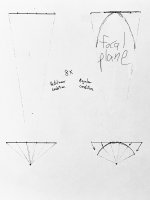Charlie Yardbird
Well-known member

So might it be that the wide angle binoculars which are said to have the best "WOW" factor for astronomic views of the night sky, will be found to have the visual distortion parameter "l" close to 1, providing a deep 3D effect?
holgermerlitz.de/globe/distortion.html -- the actual URL is missing the "https://www/" portion, which malformation seems to be making the boards expansion function choke:
Distortion and globe effect in binoculars
by Holger Merlitz
There is another interesting fact to be noticed: Some of the test persons reported on the impression of an apparent image curvature. They observed a convex curvature in case of the tangent condition (k=1) and a concave curvature in case of the angle condition (k=0), while the circle condition (k=0.5) and the k=0.7 checkerboard appeared almost flat. This can be interpreted as an intrinsic curvature of our visual space, that is compensated through the binocular when using a pincushion distortion of about k=0.6.
Such an intrinsic, convex curvature would explain another daily life experience: Why does the curvature of the night sky not resemble that of a half sphere? It seems to have a concave shape, but appears to be somehow flatter than a semi-sphere, rather looking like the inside of a flat bowl, or a wok. In fact, if our visual distortion parameter were equal to unity, l=1, then we would get the impression of a perfect semi-sphere, and in case l=0 the sky might appear flat. A value somewhere in between, e.g. l=0.6, would very well explain our perceived curvature of the night sky.
holgermerlitz.de/globe/distortion.html -- the actual URL is missing the "https://www/" portion, which malformation seems to be making the boards expansion function choke:
Distortion and globe effect in binoculars
by Holger Merlitz
There is another interesting fact to be noticed: Some of the test persons reported on the impression of an apparent image curvature. They observed a convex curvature in case of the tangent condition (k=1) and a concave curvature in case of the angle condition (k=0), while the circle condition (k=0.5) and the k=0.7 checkerboard appeared almost flat. This can be interpreted as an intrinsic curvature of our visual space, that is compensated through the binocular when using a pincushion distortion of about k=0.6.
Such an intrinsic, convex curvature would explain another daily life experience: Why does the curvature of the night sky not resemble that of a half sphere? It seems to have a concave shape, but appears to be somehow flatter than a semi-sphere, rather looking like the inside of a flat bowl, or a wok. In fact, if our visual distortion parameter were equal to unity, l=1, then we would get the impression of a perfect semi-sphere, and in case l=0 the sky might appear flat. A value somewhere in between, e.g. l=0.6, would very well explain our perceived curvature of the night sky.






